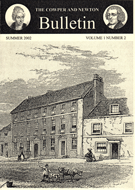The mid—nineteenth century saw the development, in Britain, of an affordable, ‘middle-class’, substitute for the white marble figures, groups, and portrait busts that adorned the homes of the rich. Most readers will be familiar with examples of this Parian porcelain, or ‘Parian ware’, so called after the marble from the Greek island of Paros. The great manufacturers, including Copeland, Goss, Minton and Robinson & Leadbeater, along with many smaller companies, issued copious single items and series through the Victorian and Edwardian periods, of all sizes, with subjects ranging from classical mythology to contemporary public figures (not only the likes of Gladstone or Disraeli but the Baptist preacher C.H. Spurgeon, whose image makes regular appearances at antique fairs). Unsurprisingly, portrait busts of famous authors formed a very popular category. Shakespeare, Burns, Scott, the Romantic poets, Dickens and Tennyson, are among the frequent examples. I have at last discovered one of Cowper. The bust, which measures about eight inches in height, is based upon the drawing by George Romney, now in the National Portrait Gallery—the one with the cap and deep appealing eyes. It was manufactured by the firm of J. and T. Bevington, which was active in Hanley (Stoke-on-Trent) c. 1865-77, making Parian ware until the early 1870s. Bevington also produced a companion piece of Alexander Pope, a writer over against whom, more than any other, Cowper defined his own poetic identity. Cowper had mixed feelings about his predecessor, commenting in ‘Table Talk’ that, though he had given ‘virtue and morality a grace’, his concern for ‘musical finesse’ was such that he had rendered poetry ‘a mere mechanic art’. The blank-verse Homer was intended specifically to replace Pope’s celebrated couplet version. Bevington thus brought together and paid tribute to the complementary geniuses of the eighteenth century—at a time when the reputations of both were alive but in decline. I would be interested to learn of any other busts of Cowper, whether in porcelain or marble itself, or a different medium. Beware, however, plaster and resin imitations! Vince Newey
The mid—nineteenth century saw the development, in Britain, of an affordable, ‘middle-class’, substitute for the white marble figures, groups, and portrait busts that adorned the homes of the rich. Most readers will be familiar with examples of this Parian porcelain, or ‘Parian ware’, so called after the marble from the Greek island of Paros. The great manufacturers, including Copeland, Goss, Minton and Robinson & Leadbeater, along with many smaller companies, issued copious single items and series through the Victorian and Edwardian periods, of all sizes, with subjects ranging from classical mythology to contemporary public figures (not only the likes of Gladstone or Disraeli but the Baptist preacher C.H. Spurgeon, whose image makes regular appearances at antique fairs). Unsurprisingly, portrait busts of famous authors formed a very popular category. Shakespeare, Burns, Scott, the Romantic poets, Dickens and Tennyson, are among the frequent examples. I have at last discovered one of Cowper. The bust, which measures about eight inches in height, is based upon the drawing by George Romney, now in the National Portrait Gallery—the one with the cap and deep appealing eyes. It was manufactured by the firm of J. and T. Bevington, which was active in Hanley (Stoke-on-Trent) c. 1865-77, making Parian ware until the early 1870s. Bevington also produced a companion piece of Alexander Pope, a writer over against whom, more than any other, Cowper defined his own poetic identity. Cowper had mixed feelings about his predecessor, commenting in ‘Table Talk’ that, though he had given ‘virtue and morality a grace’, his concern for ‘musical finesse’ was such that he had rendered poetry ‘a mere mechanic art’. The blank-verse Homer was intended specifically to replace Pope’s celebrated couplet version. Bevington thus brought together and paid tribute to the complementary geniuses of the eighteenth century—at a time when the reputations

